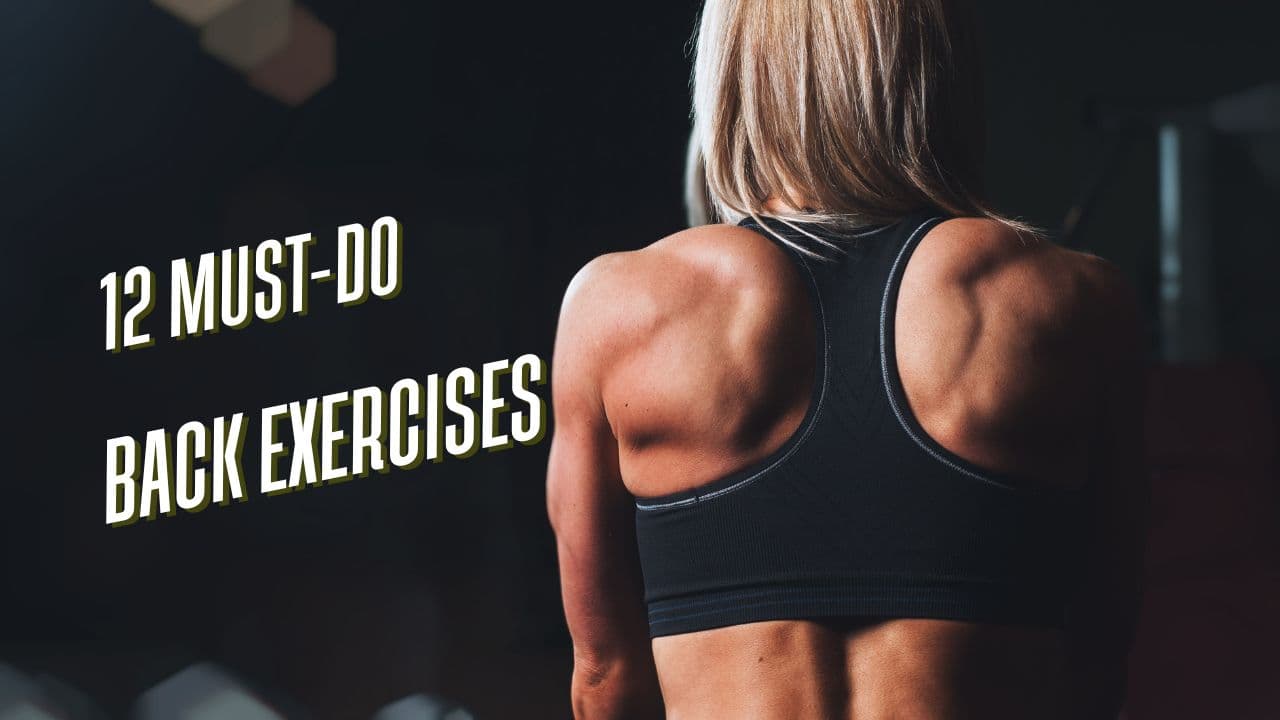Why Back Training Matters
So, let’s start with the thing most people notice last: your back is quietly running the show.
If your posture feels like "laptop goblin meets couch potato," that is usually a back problem waiting for a louder opinion.
A well-trained back supports your spine, cleans up your posture, and makes every pull, carry, and deadlift feel less like a gamble and more like a controlled decision. Strong lats, mid-back, and spinal erectors help you stand taller, move heavier weight, and keep your shoulders from living somewhere near your ears after a long workday.
The 12 exercises in this guide are pulled straight from the LoadMuscle database and cover pretty much every situation: bands in a cramped living room, cables in a big-box gym, dumbbells, kettlebells, plate-loaded machines, pure bodyweight, and a bit of mobility work to keep everything moving smoothly instead of creaking like an old door.
How to Use This Guide
Think of this guide less like a strict program and more like a menu where everything actually belongs together.
- Start each back session with a big compound pull using a barbell, cable, or bodyweight so you can load the lats and mid-back when you are freshest.
- In most workouts, pair one horizontal pull (a row) with one vertical pull (a chin or pulldown) for complete back coverage.
- Add in unilateral work regularly to clean up left-right imbalances and improve your mind-muscle connection.
- Wrap things up with extension or mobility drills to keep your posterior chain durable instead of just tired.
- Rotate equipment week to week, but keep your total hard sets in that 10–20 range so you actually progress instead of just collecting soreness.
Back Exercise Snapshot
Here is your at-a-glance cheat sheet if you like to skim first and read later.
| # | Exercise | Equipment | Target | Intensity | Skill |
|---|---|---|---|---|---|
| 1 | Band Squat Row | Band | Back | Medium | Intermediate |
| 2 | Cable Elevated Row | Cable | Latissimus Dorsi | Medium | Intermediate |
| 3 | Suspender Inverted Row | Suspension | Back | Medium | Intermediate |
| 4 | Dumbbell One Arm Row (rack support) | Dumbbell | Latissimus Dorsi | Medium | Intermediate |
| 5 | Barbell Bent Over Row | Barbell | Latissimus Dorsi | Medium | Intermediate |
| 6 | Cable Straight Arm Pulldown | Cable | Latissimus Dorsi | Medium | Intermediate |
| 7 | Chin Up | Body weight | Latissimus Dorsi | High | Intermediate |
| 8 | Lever Seated Row (plate loaded) | Leverage machine | Latissimus Dorsi | Medium | Intermediate |
| 9 | Kettlebell Two Arm Row | Kettlebell | Latissimus Dorsi | Medium | Intermediate |
| 10 | Resistance Band Floor Hyperextension | Resistance Band | Erector Spinae | Medium | Intermediate |
| 11 | Bird Dog | Body weight | Erector Spinae | Medium | Beginner |
| 12 | Cat Stretch | Body weight | Erector Spinae | Low | Beginner |
The 12 Must-Do Back Exercises
Each movement below gets a quick “why,” some simple execution cues, and one way to level it up. Pick a few that match your setup and training split, then cycle through them over time instead of trying to cram all 12 into one marathon session.
1. Band Squat Row
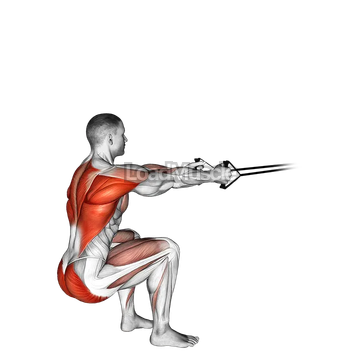
Primary focus: Back
Why it matters:
This one feels like a hybrid between a squat and a row, which is exactly what it is and why it hits so well. You use the legs to settle into a mini squat while the band keeps your upper back honest, making a simple band feel way more serious than it looks. It is especially handy if you train at home or want to wake things up before getting under a heavier row or deadlift.
Programming cues
- Sink into a shallow, quarter squat to preload your hips without turning it into a full squat.
- Keep your elbows snug to your sides as you pull the handles in toward your ribs.
- Maintain steady tension in the band instead of letting it go slack and yank you around.
Progression idea:
Bump the difficulty by pausing for half a second at the squeeze on every rep, or step a bit farther from the anchor or use a thicker band for 3–4 sets of about 12 controlled reps.
2. Cable Elevated Row
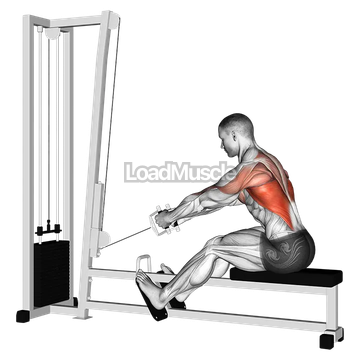
Primary focus: Latissimus Dorsi
Why it matters:
By lying or leaning on an incline bench and rowing from a slightly elevated angle, you recruit more upper-back and lat fibers while the cable keeps the tension smooth instead of choppy. It feels a bit like a hybrid between a chest-supported row and a traditional cable row, and it saves your lower back from doing unnecessary overtime.
Programming cues
- Set the bench on a mild incline and brace your chest firmly against the pad.
- Drive your elbows out and back, finishing each rep by squeezing your shoulder blades together.
- Let the handle return under control for 2–3 seconds so you do not waste the eccentric.
Progression idea:
Use a simple pyramid: 12 reps, then 10, then 8, nudging the weight up each round as long as your form still looks like something you would actually coach someone else to do.
3. Suspender Inverted Row

Primary focus: Back
Why it matters:
Suspension rows are sneaky. They make your core and glutes work just to keep your body in a straight line while your upper back pulls, which carries over surprisingly well to barbell rows and even pressing. If your regular rows feel a bit sloppy, this drill will tell on you pretty quickly.
Programming cues
- Hold your body in a straight plank from head to heels, no sagging at the hips.
- Start each rep by pulling your shoulder blades back, then follow with the arms.
- Walk your feet closer to the anchor point to make things tougher, or farther away to make it more forgiving.
Progression idea:
Prop your feet up on a bench to increase the angle, or add short isometric holds at the top for a couple of seconds per rep when you are feeling brave.
4. Dumbbell One Arm Row (Rack Support)
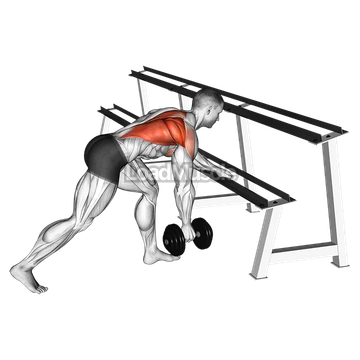
Primary focus: Latissimus Dorsi
Why it matters:
This is the classic “go heavy but stay honest” row. Using a rack or bench for support lets you keep your spine neutral while each side of your body works on its own. That helps correct imbalances, lengthens the range of motion, and quietly forces your core and obliques to resist rotation.
Programming cues
- Plant your non-working hand on the rack or bench so your torso stays flat and stable.
- Drive the working elbow back past your torso without shrugging the shoulder toward your ear.
- Allow a gentle stretch at the bottom of each rep without twisting or corkscrewing your torso.
Progression idea:
Use rep waves like 12, then 10, then 8 per side, nudging the load up each set while keeping your form crisp instead of turning it into a lawnmower tug-of-war.
5. Barbell Bent Over Row
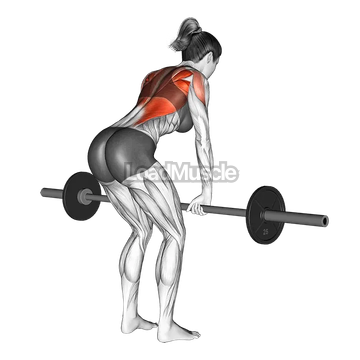
Primary focus: Latissimus Dorsi
Why it matters:
This is one of those big, no-nonsense pulls that builds your lats, rhomboids, traps, and even your grip, all while reinforcing a solid hip hinge that pays off in deadlifts and athletic movements. When people talk about “old school” back training, this is usually what they are secretly picturing.
Programming cues
- Hinge at the hips until your torso is roughly at a 45 degree angle and lock your spine in a neutral position.
- Pull the bar toward your lower ribs with a firm, neutral wrist and keep your elbows tracking close.
- Keep the bar close to your body rather than letting it drift forward and drag on your lower back.
Progression idea:
Alternate between overhand and underhand grips from week to week to stress different fibers and keep your elbows and shoulders happier in the long run.
6. Cable Straight Arm Pulldown
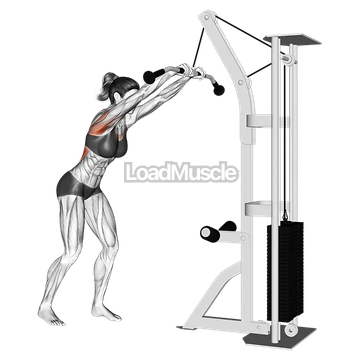
Primary focus: Latissimus Dorsi
Why it matters:
Straight arm pulldowns are like a polite but firm reminder that your lats can work without your biceps stealing the spotlight. By minimizing elbow flexion, you isolate the lats and teach a clean, sweeping pull that pairs nicely with almost any row or pull variation.
Programming cues
- Stand tall with a slight bend in your knees and your core braced.
- Sweep the bar or rope down in a smooth arc, keeping your arms mostly straight and your ribs from flaring.
- Pause when your hands reach your thighs and feel the lats contract before letting the cable return.
Progression idea:
Run 3 sets of 15 with slow 3 second lowers on each rep to rack up time under tension without needing to load the stack to the ceiling.
7. Chin Up
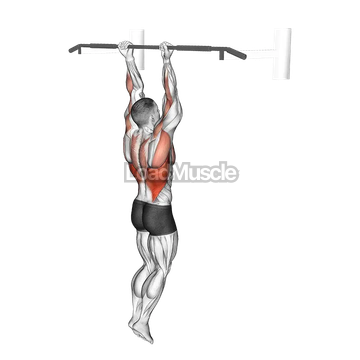
Primary focus: Latissimus Dorsi
Why it matters:
If there is a single move that tells you how your upper body strength is trending, it is probably the chin up. It stacks the lats, biceps, and mid-back stabilizers into one brutally honest test. No cable tricks, no fancy machine settings, just you and the bar and gravity doing its thing.
Programming cues
- Start in a true dead hang with your shoulders gently pulled down, not stuffed into your ears.
- Lead with your chest as you drive your elbows toward your ribs instead of just “pulling with your arms.”
- Lower yourself under control, resisting the urge to free-fall on the way down to keep your joints happy.
Progression idea:
Once you own about 8 clean reps, add a dip belt or hold a dumbbell between your feet, or play with longer 3 second negatives to build strength even if you are not ready for heavy added weight yet.
8. Lever Seated Row (Plate Loaded)
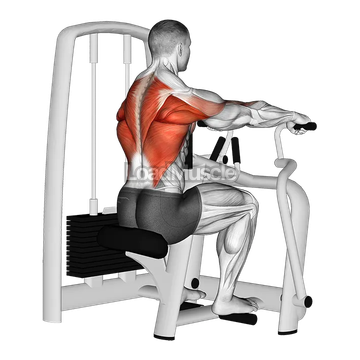
Primary focus: Latissimus Dorsi
Why it matters:
Plate-loaded row machines provide stability so your lower back can chill while your upper back and lats push closer to failure. That makes them perfect for getting extra volume without feeling like your spine is filing a complaint after every set.
Programming cues
- Adjust the chest pad so your shoulders line up comfortably with the handles instead of reaching too far.
- Drive through your elbows, keeping your wrists neutral and your grip firm but not death-claw tight.
- Finish each rep with a solid scapular squeeze before guiding the weight back instead of letting it crash.
Progression idea:
Use drop sets: hit a hard set of 10, quickly strip some weight, and keep rowing right away to extend the set without trashing your form completely.
9. Kettlebell Two Arm Row

Primary focus: Latissimus Dorsi
Why it matters:
Kettlebells bring a slightly different feel because of the offset load and neutral grip, making your core work a little overtime while your lats and traps light up. It has a rugged, no-frills vibe that works well in small spaces or minimalist setups.
Programming cues
- Hinge at your hips so the kettlebells hang just below your shoulders, with your back flat and your weight balanced over midfoot.
- Row the bells up powerfully, pause briefly at the top, then lower them under control.
- Keep your ribs tucked and avoid overarching your lower back as things get heavier.
Progression idea:
Try sets where every rep finishes with a short 2 second hold at the top, or alternate between normal tempo reps and paused reps within the same set.
10. Resistance Band Floor Hyperextension
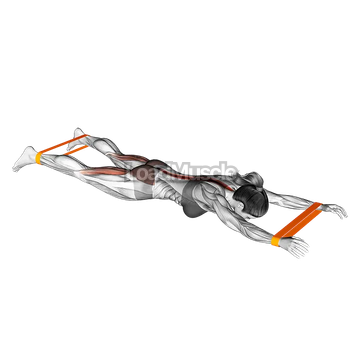
Primary focus: Erector Spinae
Why it matters:
If you want your deadlifts and hinges to stay in the game long term, your lower back and glutes need endurance, not just top-end strength. This banded floor variation gives you that slow burn without needing a big hyperextension machine, which is nice if you are in a crowded gym or training at home.
Programming cues
- Anchor the band securely under a bench, rack, or trusted partner’s feet so it does not slip.
- Squeeze your glutes and raise your chest gently off the floor, keeping your neck in line with your spine.
- Focus on smooth, deliberate reps instead of jerking your body off the ground.
Progression idea:
Increase band tension or add 1–2 second holds at the top of each rep, especially on the last few reps when your form still looks decent.
11. Bird Dog
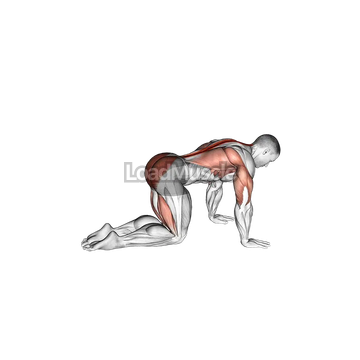
Primary focus: Erector Spinae
Why it matters:
Bird Dogs look simple, sometimes almost too simple, but they are quietly training your spine to resist unwanted rotation and extension. That kind of control shows up when you brace for heavy pulls, squats, or even daily life stuff like picking up a suitcase that weighs way more than the airline tag claims.
Programming cues
- Set your wrists under your shoulders and your knees under your hips in a steady quadruped position.
- Reach your opposite arm and leg long while keeping your hips level and your torso stable.
- Imagine balancing a glass of water on your lower back and not wanting to mop the floor after.
Progression idea:
Add small ankle or wrist weights, or slow the movement down into 3 second reaches out and 3 second returns so your core cannot just rush through it.
12. Cat Stretch

Primary focus: Erector Spinae
Why it matters:
Muscle is great, but if your spine feels like a rusty hinge every time you stand up from the sofa, you are missing the mobility piece. The Cat Stretch gently moves your spine through flexion and extension so your nervous system chills out and your back stops feeling like it is carrying the last three years of stress.
Programming cues
- From a hands-and-knees position, round your spine toward the ceiling as you exhale, pressing the floor away.
- Slowly reverse into gentle extension as you inhale, lifting your chest and tailbone without forcing it.
- Move as if you are trying to feel each small segment of your spine glide, not just flopping back and forth.
Progression idea:
Use this between heavy pulling sets as a reset, or pair it with deep, slow breathing on recovery days when you feel stiff but not totally wiped out.
Weekly Back Programming Templates
Here are some simple frameworks so you do not have to reinvent back day every single week.
| Level | Frequency | Structure | Volume Focus | Notes |
|---|---|---|---|---|
| Beginner | 2× per week | 1 row + 1 vertical pull + core/mobility | 2–3 sets of 10–12 | Prioritize technique with Bird Dog & Cat Stretch daily. |
| Intermediate | 2–3× per week | Heavy row + vertical pull + unilateral + extension | 3–4 sets of 6–12 | Rotate grips and equipment weekly for balanced overload. |
| Advanced | 3× per week | Push-pull split with contrast work | 4–5 sets of 5–15 | Mix tempo (slow eccentrics) and intensity techniques (drop sets, weighted chins). |
Sample Splits
- Upper/Lower: On your upper day, open with Barbell Bent Over Rows and follow with Chin Ups. On the next upper session, run Lever Seated Rows plus Cable Straight Arm Pulldowns.
- Push/Pull/Legs: On pull day, start with weighted Chin Ups, then Dumbbell One Arm Rows, finishing with Resistance Band Floor Hyperextensions for lower-back endurance.
- At-Home: Cycle Band Squat Row → Suspender Inverted Row → Bird Dog → Cat Stretch for a compact session that hits strength and control without a full gym.
Build Your Personalized Back Day
If picking sets and reps feels like scrolling Netflix for 40 minutes and watching nothing, let the LoadMuscle AI Workout Planner do the boring part. It uses the same exercise database behind this article, checks your equipment, recovery, and goals, and spits out something that looks like an actual plan instead of a random list.
You get:
- Tailored exercise order that makes sense with your split
- Auto-calculated intensities so you are not guessing every week
- Built-in mobility and core work so your back feels supported, not just sore
👉 Try it here: Online Fitness Planner
Conclusion
Back training is not just about chasing a wider V-taper. It is about mixing heavy compound pulls, smarter isolation work, and simple mobility drills so your body feels strong and usable in real life, not just under gym lighting. Use these 12 exercises as your core toolkit, rotate your equipment and grips, and lean on the workout planner whenever you want a fresh, data-backed progression without overthinking every little detail. And if your posture starts to creep back into gremlin mode again, you will know exactly where to start fixing it.
